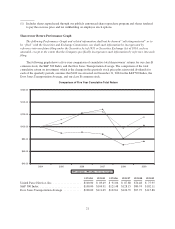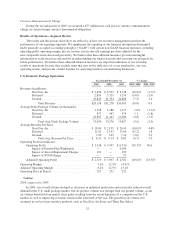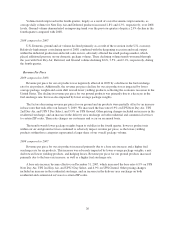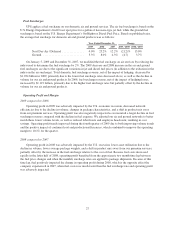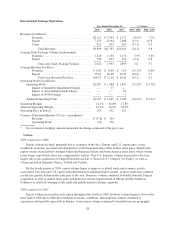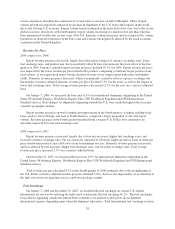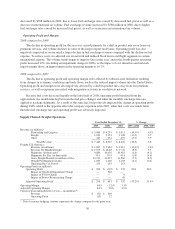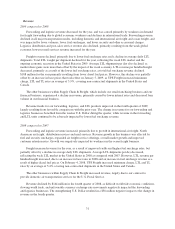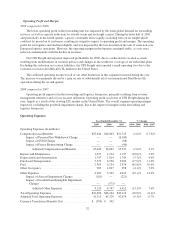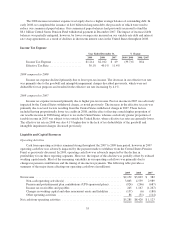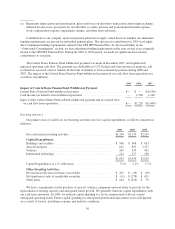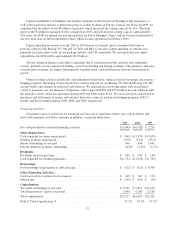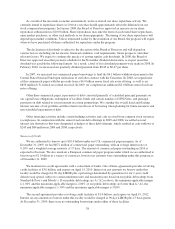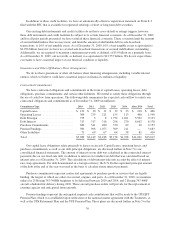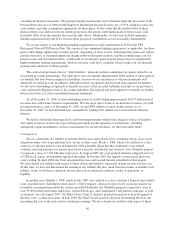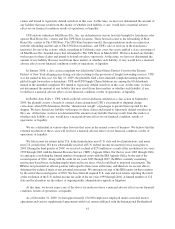UPS 2009 Annual Report Download - page 43
Download and view the complete annual report
Please find page 43 of the 2009 UPS annual report below. You can navigate through the pages in the report by either clicking on the pages listed below, or by using the keyword search tool below to find specific information within the annual report.Revenue
2009 compared to 2008
Forwarding and logistics revenue decreased for the year, and was caused primarily by weakness in demand
for freight forwarding due to global economic weakness and declines in international trade. Forwarding revenue
declined in all major transportation modes, including domestic and international air freight and ocean freight, and
was impacted by lower volumes, lower fuel surcharges, and lower security and other accessorial charges.
Logistics distribution and post-sales service revenue also declined, primarily resulting from the weak global
economy, however mail services revenue increased for the year.
Freight revenue declined, primarily due to lower fuel surcharge rates and a decline in average daily LTL
shipments. Total LTL weight per shipment declined for the year, reflecting the weak LTL market and the
ongoing economic recession in the United States in 2009. Average LTL shipments per day also declined, as
market share gains were more than offset by the impact of the weak economy. LTL revenue per hundredweight
decreased, primarily as a result of the lower fuel surcharge rates, as total fuel surcharge revenue declined
$188 million for the year primarily resulting from lower diesel fuel prices. However, this decline was partially
offset by an increase in base prices that took effect on January 5, 2009, as UPS Freight increased minimum
charge, LTL and TL rates an average of 5.9%, covering non-contractual shipments in the United States and
Canada.
The other businesses within Supply Chain & Freight, which include our retail franchising business and our
financial business, experienced a decline in revenue, primarily caused by lower interest rates and decreased loan
volume in our financial business.
Revenue trends for our forwarding, logistics, and LTL products improved in the fourth quarter of 2009,
largely resulting from favorable comparisons with the prior year. The change in revenue for our forwarding and
logistics businesses benefited from the weaker U.S. Dollar during the quarter, while revenue in the forwarding
and LTL units continued to be adversely impacted by lower fuel surcharge revenue.
2008 compared to 2007
Forwarding and logistics revenue increased, primarily due to growth in international air freight, North
American air freight, distribution services and mail services. Revenue growth in this business was affected by
fuel and security surcharges, expanded air freight service offerings, overall market growth and improved
customer retention rates. Growth was negatively impacted by weakness in the ocean freight business.
Freight increased revenue for the year, as a result of improved yields and higher fuel surcharge rates, but
partially offset by a decline in average daily LTL shipments. Average LTL shipments per day decreased,
reflecting the weak LTL market in the United States in 2008 as compared with 2007. However, LTL revenue per
hundredweight increased, due to an increase in base rates in 2008 and an increase in fuel surcharge revenue as a
result of higher diesel fuel prices. On February 4, 2008, UPS Freight increased minimum charge, LTL and TL
rates by an average of 5.4% covering non-contractual shipments in the United States and Canada.
The other businesses within Supply Chain & Freight increased revenue, largely due to our contract to
provide domestic air transportation services for the U.S. Postal Service.
Revenue declined by $144 million in the fourth quarter of 2008, as difficult worldwide economic conditions,
slowing world trade, and unfavorable currency exchange rate movements negatively impacted the forwarding
and logistics businesses. The strengthening U.S. Dollar resulted in a $58 million negative impact to the change in
revenue in the fourth quarter.
31


